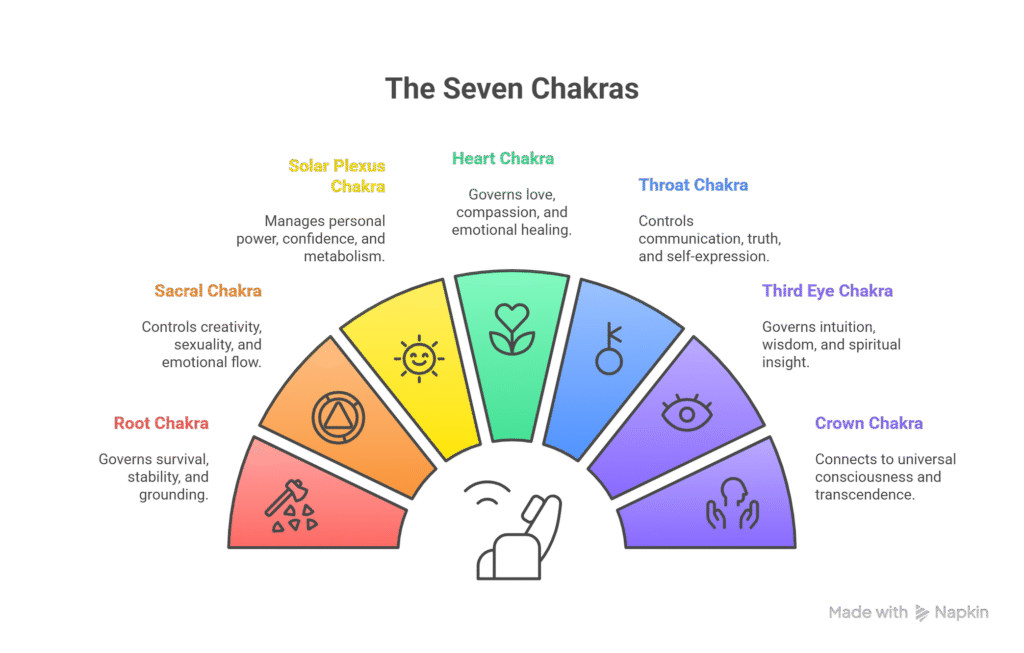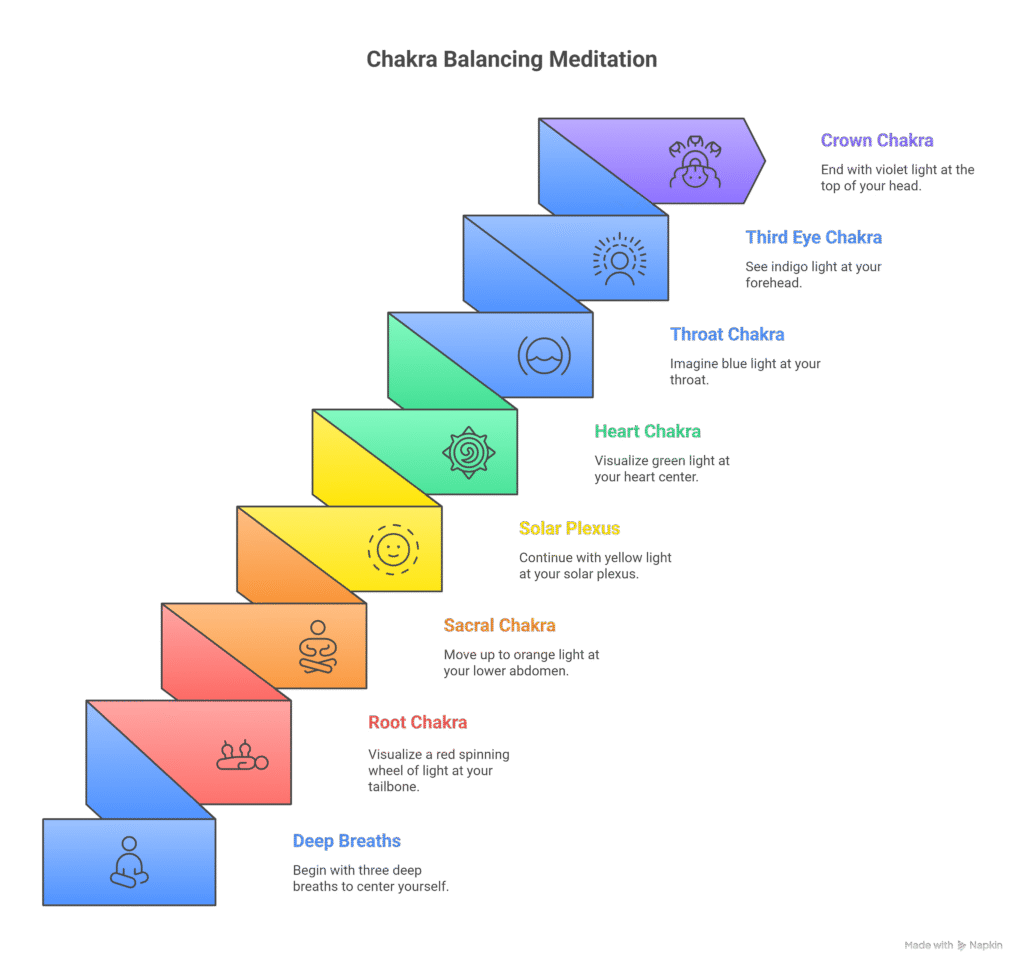Introduction to Chakra Meditation
In our fast-paced digital world, millions are in pursuit of ancient wisdom for modern healing. Chakra meditation for beginners offers a powerful gateway to inner balance, combining 5,000-year-old energy practices with contemporary wellness needs. Whether you’re dealing with workplace stress, digital overwhelm, or simply seeking deeper self-awareness, meditation for beginners focused on chakras provides a structured path to energetic harmony.
The chakra system, originating from ancient Indian traditions, recognizes seven main energy centers that influence your physical, emotional, and spiritual well-being. When these energy centers become blocked or imbalanced, you may experience fatigue, anxiety, creative blocks, or relationship difficulties. How to balance chakras with meditation becomes essential for maintaining optimal life force energy.
Understanding Your Seven Energy Centers
Before diving into chakra meditation techniques for beginners, it’s crucial to understand what you’re working with. Your chakras are spinning wheels of energy that correspond to different aspects of your human experience.

The Seven Main ChakrasHeading Text Here
Root Chakra (Muladhara)
Located at the base of your spine, governs survival, stability, and grounding. When balanced, you feel secure and confident in life’s challenges.
Sacral Chakra (Svadhishthana)
Positioned below your navel, controls creativity, sexuality, and emotional flow. A healthy sacral chakra supports healthy relationships and creative expression.
Solar Plexus Chakra (Manipura)
Found in your upper abdomen, manages personal power, confidence, and metabolism. This energy center fuels your ability to take action and manifest your desires.
Heart Chakra (Anahata)
Located at your chest center, governs love, compassion, and emotional healing. How to open chakras through meditation often begins here, as heart opening creates space for deeper spiritual connection.
Throat Chakra (Vishuddha)
Positioned at your throat, controls communication, truth, and authentic self-expression. Many modern practitioners find throat chakra work particularly relevant in our communication-heavy digital age.
Third Eye Chakra (Ajna)
Located between your eyebrows, governs intuition, wisdom, and spiritual insight. This chakra bridges your physical and spiritual awareness.
Crown Chakra (Sahasrara)
At the top of your head, connects you to universal consciousness and spiritual transcendence.
7 Essential Chakra Meditation Techniques for Beginners
Technique 1: Color Visualization Meditation

This beginner meditation technique uses color association to activate and balance each chakra. Find a comfortable seated position and close your eyes.
Step-by-step process:
- Begin with three deep breaths to center yourself
- Visualize a red spinning wheel of light at your tailbone (Root Chakra)
- Breathe into this red light for 1-2 minutes, imagining it growing brighter
- Move up to orange light at your lower abdomen (Sacral Chakra)
- Continue with yellow (Solar Plexus), green (Heart), blue (Throat), indigo (Third Eye), and violet (Crown)
- Spend 1-2 minutes with each color, breathing life into these energy centers
This guided chakra meditation approach works particularly well for visual learners and provides immediate energetic shifts.
Technique 2: Sound and Mantra Activation

Ancient Sanskrit sounds, called bija mantras, create specific vibrations that activate your chakras. How to start chakra meditation with sound requires no previous experience—just your voice and intention.
The seven chakra sounds:
- Root: “LAM” (pronounced “lahm”)
- Sacral: “VAM” (pronounced “vahm”)
- Solar Plexus: “RAM” (pronounced “rahm”)
- Heart: “YAM” (pronounced “yahm”)
- Throat: “HAM” (pronounced “hahm”)
- Third Eye: “OM” (pronounced “ohm”)
- Crown: “OM” or silence
Chant each sound for 1-2 minutes while focusing on the corresponding chakra location. The vibrations create internal massage and energetic activation.
Technique 3: Breath-Focused Chakra Balancing
This chakra balancing meditation combines specific breathing patterns with chakra awareness, making it ideal for those who prefer subtle energy work.
Practice instructions:
- Sit comfortably with your spine straight
- Place your hand on your tailbone area (Root Chakra)
- Breathe deeply into this area for 7 counts
- Hold for 4 counts, then exhale for 8 counts
- Move your hand to each chakra location, repeating this breathing pattern
- Notice any sensations, warmth, or tingling as you breathe into each energy center
This technique builds body awareness while gently activating your energy system.
Technique 4: Progressive Chakra Scan
Similar to a body scan meditation, this chakra meditation technique for beginners systematically moves through your energy centers, identifying blockages and facilitating flow.
Scanning process:
- Lie down comfortably or sit with good posture
- Start at your tailbone, mentally scanning for any tension, numbness, or sensation
- Ask yourself: “How does my Root Chakra feel today?”
- Notice without judgment—blocked chakras may feel heavy, tight, or absent
- Move systematically through each chakra, spending 2-3 minutes per center
- End by visualizing golden light flowing freely through all seven chakras
This introspective approach develops chakra sensitivity and self-awareness.
Technique 5: Movement-Based Chakra Activation
For those who find sitting meditation challenging, how to balance chakras with meditation can include gentle movement and yoga-inspired postures.
Movement sequence:
- Begin in mountain pose, connecting to earth energy (Root)
- Hip circles and gentle pelvic movements (Sacral)
- Twisting motions and core strengthening (Solar Plexus)
- Heart opening stretches and arm movements (Heart)
- Neck rolls and shoulder releases (Throat)
- Gentle head movements and forehead massage (Third Eye)
- Reaching arms skyward and crown of head awareness (Crown)
This approach integrates physical and energetic healing.
Technique 6: Crystal and Stone Meditation
While not essential, crystals can amplify your guided chakra meditation practice by providing specific vibrational frequencies that support chakra balancing.
Crystal correspondences:
- Red Jasper or Hematite (Root)
- Carnelian or Orange Calcite (Sacral)
- Citrine or Yellow Jasper (Solar Plexus)
- Rose Quartz or Green Aventurine (Heart)
- Blue Lace Agate or Sodalite (Throat)
- Amethyst or Lapis Lazuli (Third Eye)
- Clear Quartz or Selenite (Crown)
Place appropriate stones on or near each chakra during meditation, allowing their natural vibrations to support your practice.
Technique 7: Affirmation-Based Chakra Work
This technique combines positive affirmations with chakra focus, addressing both energetic and psychological aspects of balance.
Chakra affirmations:
- Root: “I am safe, secure, and grounded in my body and life”
- Sacral: “I embrace my creativity and honor my emotional flow”
- Solar Plexus: “I am confident in my personal power and ability to create change”
- Heart: “I give and receive love freely and authentically”
- Throat: “I speak my truth with clarity and kindness”
- Third Eye: “I trust my intuition and inner wisdom”
- Crown: “I am connected to the divine source within and around me”
Repeat each affirmation while focusing on the corresponding chakra for 1-2 minutes.
Common Beginner Mistakes to Avoid
Forcing experiences: Many new practitioners try to “make” something happen rather than allowing natural energy flow. Chakra meditation for beginners works best with gentle attention and patience.
Neglecting grounding: Always begin chakra work with root chakra connection. Skipping this foundation can leave you feeling spacey or disconnected.
Inconsistent practice: Sporadic meditation sessions provide limited benefits. Even 10 minutes daily surpasses hour-long weekly sessions for energy balancing.
Expecting immediate results: Chakra balancing is a gradual process. Some people feel shifts immediately, while others need weeks of consistent practice to notice changes.
Benefits of Regular Chakra Meditation Practice
Research shows that meditation for beginners who focus on energy centers experience improved stress management, emotional regulation, and overall well-being. Regular chakra balancing meditation can lead to:
- Enhanced emotional stability and resilience
- Improved physical energy and vitality
- Clearer communication and self-expression
- Stronger intuitive abilities and decision-making
- Deeper spiritual connection and purpose
- Better relationships and social interactions
- Increased creativity and problem-solving abilities
Creating Your Daily Practice
How to start chakra meditation successfully requires consistency over intensity. Begin with 10-15 minutes daily, choosing one technique that resonates with you. As your practice develops, you can combine methods or extend session length.
Weekly practice suggestion:
- Monday: Color visualization meditation
- Tuesday: Sound and mantra activation
- Wednesday: Breath-focused balancing
- Thursday: Progressive chakra scan
- Friday: Movement-based activation
- Saturday: Crystal meditation (if available)
- Sunday: Affirmation-based practice
This comprehensive approach to chakra meditation techniques for beginners honors ancient wisdom while addressing contemporary wellness needs. Remember, your chakra system is as unique as your fingerprint—what works for others may need adjustment for your individual energy signature.
As you embark on this transformative journey, trust your inner guidance and allow your practice to evolve naturally. The seven chakras offer a complete roadmap for energetic healing, emotional balance, and spiritual growth that has supported human well-being for millennia.


